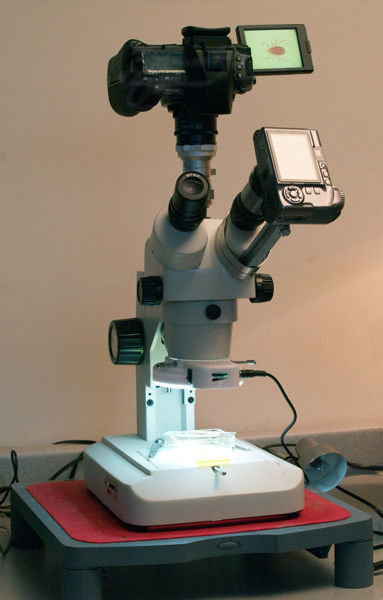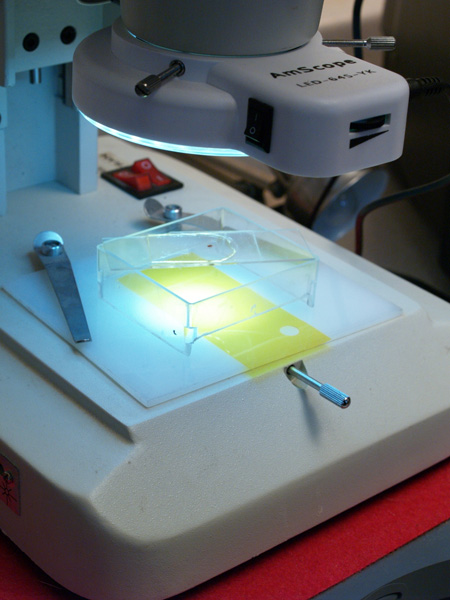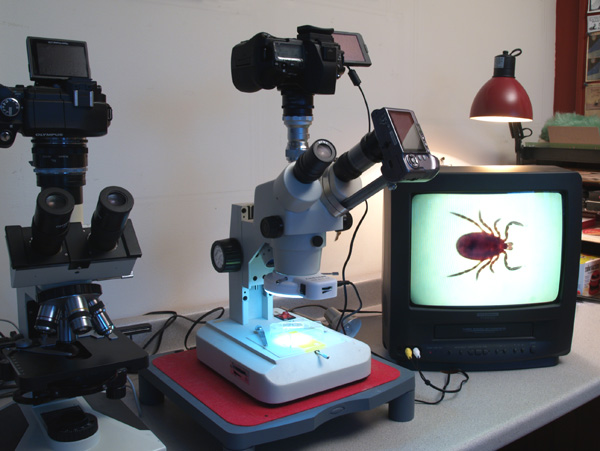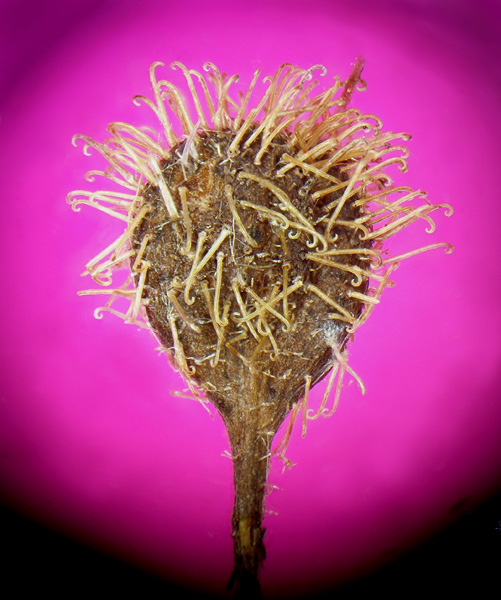
Using Live View and a Television in Photomicroscopy
by Michael Reese Much RMS EMS
Bethlehem, Pennsylvania, USA
Numerous digital cameras today have the Live View feature with which images can be previewed in real time on the LCD monitor. In addition to assisting in framing the image, Live View also displays the effects of settings being applied in the camera to control image quality factors such as exposure and white balance. In many digital cameras the Live View image can also be streamed outside of the camera to be displayed on monitors and television screens.

This is the setup on my trinocular stereo microscope in my microscope lab. Mounted on the right eyepiece is an Olympus SP-320 digital camera. On the trinocular photo tube, an Olympus E-5 DSLR is mounted using a Pentax M42 microscope adapter and an M42 to Four Thirds camera adapter. The relay lens is an Olympus 2.5X NFK photo eyepiece. I found the Pentax adapter at KEH.com, where I purchase a lot of my macro equipment, including lenses, extension tubes and bellows. You can see the Live View image on the articulated LCD screen.
On the stage of my stereo microscope, the slide is raised above a yellow Rosco gel filter to keep the filter and its dust out of focus.

There is a cutout on the slide holder that allows me to insert gels or colored paper backgrounds without disturbing the slide itself.
Using the camera’s AV (Audio Visual) cord in the AV OUT jack of the camera and connecting it to a television set, enables display of the Live View image from the monitor to be streamed to the television set.

In this example, a Deer Tick is displayed on the television screen.
There are numerous advantages to displaying the Live View image on a TV screen.
First, it enables critical focus, particularly when parfocality is not possible, as is the case with my stereo microscope. I can focus and shoot while viewing an enlarged view of the specimen. Since Olympus DSLR and PEN cameras (and others) offer a magnified view, even better critical focus can be obtained with high magnifications on compound microscopes. In the case of cameras such as the E-5 that have separate USB ports and AV OUT ports, the image can be viewed and the USB port can be used with computer camera control software.
Second, the larger view offered by the television screen can assist in shooting focus stacks, such as this focus stack of a burr.

Lastly, in the case of my television setup, the television has a built in VHS recorder, so the Live View images can be saved to videotape and then converted to DVD to digitize them.
Comments to Michael Reese Much are welcomed.
Microscopy UK Front
Page
Micscape
Magazine
Article
Library
Published in the January 2011 edition of Micscape Magazine.
Please report any Web problems or offer general comments to the Micscape Editor .
Micscape is the on-line monthly magazine of the Microscopy UK website at Microscopy-UK .
© Onview.net Ltd, Microscopy-UK, and all contributors 1995 onwards. All rights reserved. Main site is at www.microscopy-uk.org.uk .